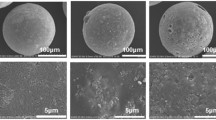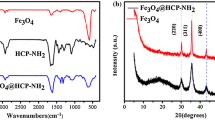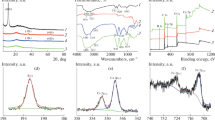Abstract
A rapid and effective method based on a novel permanent magnetic hypercrosslinked resin W150 was proposed for the removal of organic micropollutants in drinking water. W150 was prepared by suspension and post-crosslinking reaction and found to possess a high specific surface area of 1149.7 m2·g−1, a small particle size of 50 μm to 100 μm, and a saturation magnetization as high as 8 emu·g−1. W150 was used to eliminate nitrofurazone (NFZ) and oxytetracycline (OTC) from drinking water compared with commercial adsorbents XAD-4 and F400D. The adsorption kinetics of NFZ and OTC onto the three adsorbents well fitted the pseudo-second-order equation (r>0.972), and the adsorption isotherms were all well described by the Freundlich equation (r>0.851). Results showed that the reduction in adsorbent size and the enlargement in sorbent pores both accelerated adsorption. Moreover, the effect of particle size on adsorption was more significant than that of pore width. Given that the smallest particle size and the highest specific surface area were possessed by W150, it had the fastest adsorption kinetics and largest adsorption capacity for NFZ (180 mg·g−1) and OTC (200 mg·g−1). For the adsorbents with dominant micropores, the sorption of large-sized adsorbates decreased because of the inaccessible micropores. The solution pH and ionic strength also influenced adsorption.
Similar content being viewed by others
References
Bound J P, Voulvoulis N. Pharmaceuticals in the aquatic environment—a comparison of risk assessment strategies. Chemosphere, 2004, 56(11): 1143–1155
Prado N, Ochoa J, Amrane A. Biodegradation by activated sludge and toxicity of tetracycline into a semi-industrial membrane bioreactor. Bioresource Technology, 2009, 100(15): 3769–3774
Batt A L, Kim S, Aga D S. Comparison of the occurrence of antibiotics in four full-scale wastewater treatment plants with varying designs and operations. Chemosphere, 2007, 68(3): 428–435
Kosutic K, Dolar D, Asperger D, Kunst B. Removal of antibiotics from a model wastewater by RO/NF membranes. Separation and Purification Technology, 2007, 53(3): 244–249
Wang P, He Y L, Huang C H. Reactions of tetracycline antibiotics with chlorine dioxide and free chlorine. Water Research, 2011, 45(4): 1838–1846
Wang Y, Zhang H, Zhang J, Lu C, Huang Q, Wu J, Liu F. Degradation of tetracycline in aqueous media by ozonation in an internal loop-lift reactor. Journal of Hazardous Materials, 2011, 192(1): 35–43
Ji L, Chen W, Bi J, Zheng S, Xu Z, Zhu D, Alvarez P J. Adsorption of tetracycline on single-walled and multi-walled carbon nanotubes as affected by aqueous solution chemistry. Environmental Toxicology and Chemistry, 2010, 29(12): 2713–2719
Ji L, Wan Y, Zheng S, Zhu D. Adsorption of tetracycline and sulfamethoxazole on crop residue-derived ashes: implication for the relative importance of black carbon to soil sorption. Environmental Science & Technology, 2011, 45(13): 5580–5586
Richter M K, Sander M, Krauss M, Christl I, Dahinden M G, Schneider M K, Schwarzenbach R P. Cation binding of antimicrobial sulfathiazole to leonardite humic acid. Environmental Science & Technology, 2009, 43(17): 6632–6638
Kahle M, Stamm C. Sorption of the veterinary antimicrobial sulfathiazole to organic materials of different origin. Environmental Science & Technology, 2007, 41(1): 132–138
Xue S, Zhao Q L, Wei L L, Hui X J, Ma X P, Lin Y Z. Fluorescence spectroscopic studies of the effect of granular activated carbon adsorption on structural properties of dissolved organic matter fractions. Frontiers of Environmental Science & Engineering, 2013, 6(6): 784–796
Ma Y, Gao N Y, Chu W H, Li C. Removal of phenol by powdered activated carbon adsorption. Frontiers of Environmental Science & Engineering, 2013, 7(2): 158–165
Zhou Q, Wang MQ, Li A M, Shuang C D, Zhang MC, Liu X H, Wu L Y. Preparation of a novel anion exchange group modified hypercrosslinked resin for the effective adsorption of both tetracycline and humic acid. Frontiers of Environmental Science & Engineering, 2013, 7(2): 412–419
Tsyurup MP, Davankov V A. Porous Structure of Hypercrosslinked Polystyrene: State-of-the-Art Mini-Review. Reactive & Functional Polymers, 2006, 66(7): 768–779
Valderrama C, Cortina J L, Farran A, Gamisans X, Lao C. Kinetics of sorption of polyaromatic hydrocarbons onto granular activated carbon and Macronet hyper-cross-linked polymers (MN200). Journal of Colloid and Interface Science, 2007, 310(1): 35–46
Zhou Y, Shuang C D, Zhou Q, Zhang M C, Li P H, Li A M. Preparation and application of a novel magnetic anion exchange resin for selective nitrate removal. Chinese Chemical Letters, 2012, 23(7): 813–816
Shuang C, Li P, Li A, Zhou Q, Zhang M, Zhou Y. Quaternized magnetic microspheres for the efficient removal of reactive dyes. Water Research, 2012, 46(14): 4417–4426
Zhou Q, Zhang M C, Shuang C D, Li Z Q, Li A M. Preparation of a novel magnetic powder resin for the rapid removal of tetracycline in the aquatic environment. Chinese Chemical Letters, 2012, 23(6): 745–748
Zhou Q, Li Z Q, Shuang C D, Li A M, Zhang M C, Wang M Q. Efficient removal of tetracycline by reusable magnetic microspheres with a high surface area. Chemical Engineering Journal, 2012, 210: 350–356
Zhou Q, Li Z Q, Shuang C D, Li A M, Wang M Q, Zhang M C. Preparation of acid-resistant magnetic adsorbent for effective removal of p-nitrophenol. Chinese Chemical Letters, 2012, 23(9): 1079–1082
Zhang M, Zhou Q, Li A, Shuang C, Wang W, Wang M. A magnetic sorbent for the efficient and rapid extraction of organic micropollutants from large-volume environmental water samples. Journal of Chromatography. A, 2013, 1316: 44–52
Martin J E, Venturini E, Odinek J, Anderson R A. Anisotropic magnetism in field-structured composites. Physical Review, 2000, 61(3): 2818–2830
Zhang M C, Li A M, Zhou Q, Shuang C D, Zhou W W, Wang M Q. Effect of pore size distribution on tetracycline adsorption using magnetic hypercrosslinked resins. Microporous and Mesoporous Materials, 2014, 184: 105–111
Yang W, Zheng F, Xue X, Lu Y. Investigation into adsorption mechanisms of sulfonamides onto porous adsorbents. Journal of Colloid and Interface Science, 2011, 362(2): 503–509
Author information
Authors and Affiliations
Corresponding author
Rights and permissions
About this article
Cite this article
Wang, W., Ma, Y., Zhou, Q. et al. Preparation of a permanent magnetic hypercrosslinked resin and assessment of its ability to remove organic micropollutants from drinking water. Front. Environ. Sci. Eng. 9, 96–104 (2015). https://doi.org/10.1007/s11783-014-0724-3
Received:
Accepted:
Published:
Issue Date:
DOI: https://doi.org/10.1007/s11783-014-0724-3




